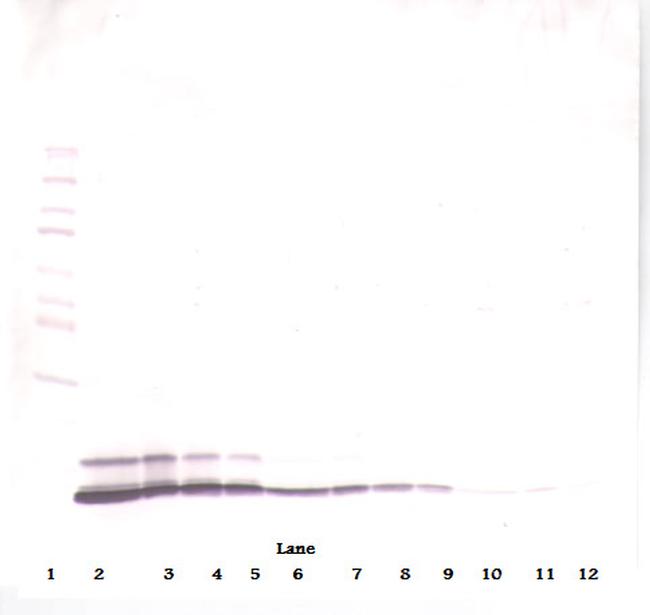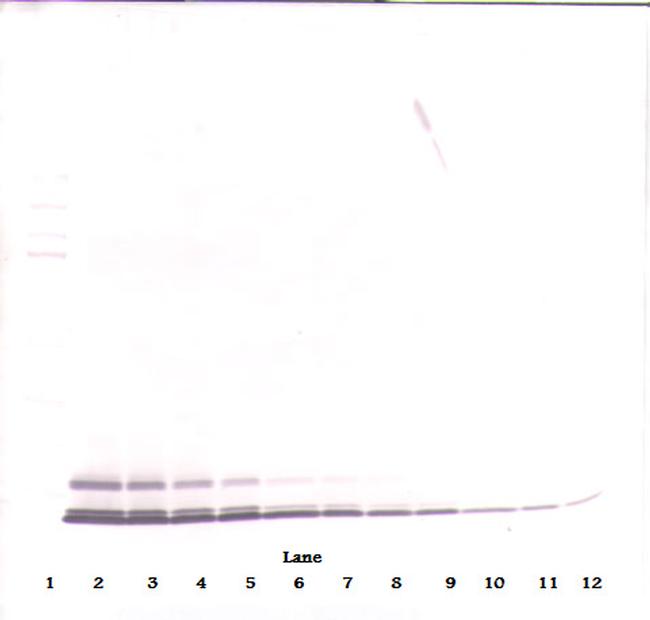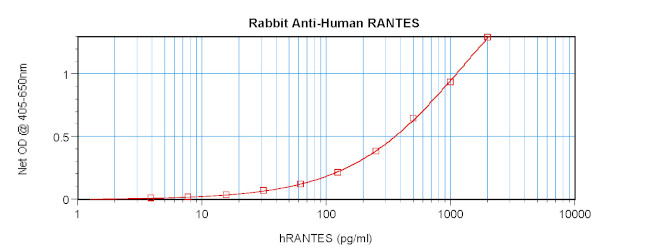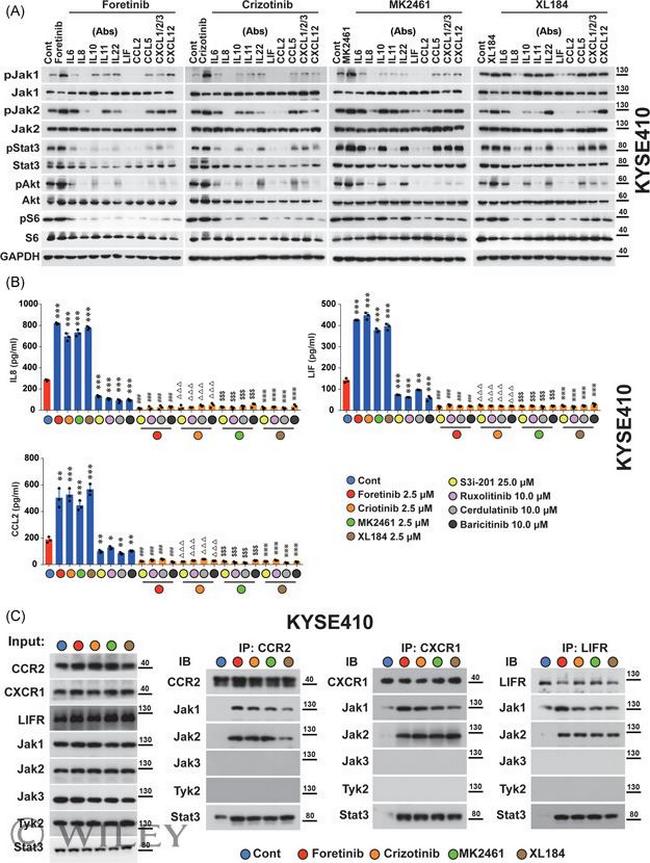RANTES, Anti-Human
Referência NB-50-1068-1
Tamanho : 1mg
Marca : Neo Biotech
Product Image Gallery

Western Blot: To detect hRANTES by Western Blot analysis CCL5 (RANTES) Polyclonal Antibody (Product # 500-P36-1MG) can be used at a concentration of 0.1-0.2 µg/mL. Used in conjunction with compatible secondary reagents the detection limit for Recombinant hRANTES is 1.5-3.0 ng/lane, under either reducing or non-reducing conditions.

Western Blot: To detect hRANTES by Western Blot analysis CCL5 (RANTES) Polyclonal Antibody (Product # 500-P36-1MG) can be used at a concentration of 0.1-0.2 µg/mL. Used in conjunction with compatible secondary reagents the detection limit for Recombinant hRANTES is 1.5-3.0 ng/lane, under either reducing or non-reducing conditions.

Sandwich ELISA: To detect Human RANTES (CCL5) by sandwich ELISA (using 100 µL/well antibody solution) a concentration of 0.5-2.0 µg/mL of CCL5 (RANTES) Polyclonal Antibody (Product # 500-P36-1MG) is required. This antigen affinity purified antibody, in conjunction with PeproTech CCL5 (RANTES) Polyclonal Antibody, Biotin (Product # 500-P36BT-1MG) as a detection antibody, allows the detection of at least 0.2-0.4 ng/well of Recombinant Human RANTES (CCL5).

6 Figure STAT3 is activated through secretion of various cytokines from ESCC cells. (A) Immunoblotting of lysates from KYSE410 cells treated with c-Met inhibitors (2.5 muM) or combined with a series of neutralizing antibodies such as IL6, IL8, IL10, IL11, IL22, LIF, CCL2, CCL5, CXCL1/2/3, CXCL12 (10 mug/ml) for 24 h. (B) Bar graphs showing IL8, LIF, and CCL2 level in supernatants from KYSE410 cells treated with c-Met inhibitors (2.5 muM) alone or combined with S3i-201 (25 muM), ruxolitinib, cerdulatinib or baricitinib (10 muM) for 24 h as measured by ELISA assay of IL8, LIF, and CCL2. Data are mean + SD ( n = 3, * p < 0.05, ** p < 0.01, *** p < 0.001 representing c-Met inhibitors, ruxolitinib, cerdulatinib, baricitinib, S3i-201 versus Cont; ### p < 0.001 representing foretinib combined with S3i-201, ruxolitinib, cerdulatinib or baricitinib versus foretinib; ^^^ p < 0.001 representing crizotinib combined with S3i-201, ruxolitinib, cerdulatinib or baricitinib versus crizotinib; $$$ p < 0.001 representing MK2461 combined with S3i-201, ruxolitinib, cerdulatinib or baricitinib versus MK2461; *** p < 0.001 representing XL184 combined with S3i-201, ruxolitinib, cerdulatinib or baricitinib versus XL184; by two-tailed unpaired Student's t test). (C) lysates from KYSE410 cells with the indicated treatment were immunoprecipitated with CCR2 (the panel of IP: CCR2), CXCR1 (the panel of IP: CXCR1), or LIFR (the panel of IP: LIFR) antibody, and then immunoblotted with the antibodies against

6 Figure STAT3 is activated through secretion of various cytokines from ESCC cells. (A) Immunoblotting of lysates from KYSE410 cells treated with c-Met inhibitors (2.5 muM) or combined with a series of neutralizing antibodies such as IL6, IL8, IL10, IL11, IL22, LIF, CCL2, CCL5, CXCL1/2/3, CXCL12 (10 µg/mL) for 24 h. (B) Bar graphs showing IL8, LIF, and CCL2 level in supernatants from KYSE410 cells treated with c-Met inhibitors (2.5 muM) alone or combined with S3i-201 (25 muM), ruxolitinib, cerdulatinib or baricitinib (10 muM) for 24 h as measured by ELISA assay of IL8, LIF, and CCL2. Data are mean +- SD (n = 3, * p < 0.05, ** p < 0.01, *** p < 0.001 representing c-Met inhibitors, ruxolitinib, cerdulatinib, baricitinib, S3i-201 versus Cont; ### p < 0.001 representing foretinib combined with S3i-201, ruxolitinib, cerdulatinib or baricitinib versus foretinib; ^^^ p < 0.001 representing crizotinib combined with S3i-201, ruxolitinib, cerdulatinib or baricitinib versus crizotinib; $$$ p < 0.001 representing MK2461 combined with S3i-201, ruxolitinib, cerdulatinib or baricitinib versus MK2461; *** p < 0.001 representing XL184 combined with S3i-201, ruxolitinib, cerdulatinib or baricitinib versus XL184; by two-tailed unpaired Student's t test). (C) lysates from KYSE410 cells with the indicated treatment were immunoprecipitated with CCR2 (the panel of IP: CCR2), CXCR1 (the panel of IP: CXCR1), or LIFR (the panel of IP: LIFR) an
Product Details
500-P36-100UG
Species Reactivity
Published species
Host/Isotype
Class
Type
Immunogen
Conjugate
Form
Concentration
Purification
Storage buffer
Contains
Storage conditions
Shipping conditions
RRID
Product Specific Information
AA Sequence of recombinant protein: SPYSSDTTPC CFAYIARPLP RAHIKEYFYT SGKCSNPAVV FVTRKNRQVC ANPEKKWVRE YINSLEMS.
Preparation: Produced from sera of rabbits immunized with highly pure Recombinant Human RANTES (CCL5). Anti-Human RANTES (CCL5)-specific antibody was purified by affinity chromatography employing an immobilized Human RANTES (CCL5) matrix.
Sandwich ELISA: To detect Human RANTES (CCL5) by sandwich ELISA (using 100 µL/well antibody solution) a concentration of 0.5-2.0 µg/mL of this antibody is required. This antigen affinity purified antibody, in conjunction with PeproTech Biotinylated Anti-Human RANTES (CCL5) (500-P36Bt) as a detection antibody, allows the detection of at least 0.2-0.4 ng/well of Recombinant Human RANTES (CCL5).
Western Blot: To detect hRANTES by Western Blot analysis this antibody can be used at a concentration of 0.1-0.2 µg/mL. Used in conjunction with compatible secondary reagents the detection limit for Recombinant hRANTES is 1.5-3.0 ng/lane, under either reducing or non-reducing conditions.
Target Information
CCL5 (RANTES) is a chemokine gene located on the q-arm of chromosome 17. Chemokines are a superfamily of secreted proteins involved in immunoregulatory and inflammatory processes. The superfamily is divided into four subfamilies based on the arrangement of the N-terminal cysteine residues of the mature peptide. CCL5, a member of the CC subfamily, functions as a chemoattractant for blood monocytes, memory T helper cells, and eosinophils. It causes the release of histamine from basophils and activates eosinophils. This cytokine is one of the major HIV-suppressive factors produced by CD8+ cells. It functions as one of the natural ligands for the chemokine receptor chemokine (C-C motif) receptor 5 (CCR5), and it suppresses in vitro replication of the R5 strains of HIV-1, which use CCR5 as a coreceptor. Alternative splicing results in multiple transcript variants that encode different isoforms. Diseases associated with CCL5 include Human Immunodeficiency Virus Type 1 and Periapical Granuloma.
For Research Use Only. Not for use in diagnostic procedures. Not for resale without express authorization.



